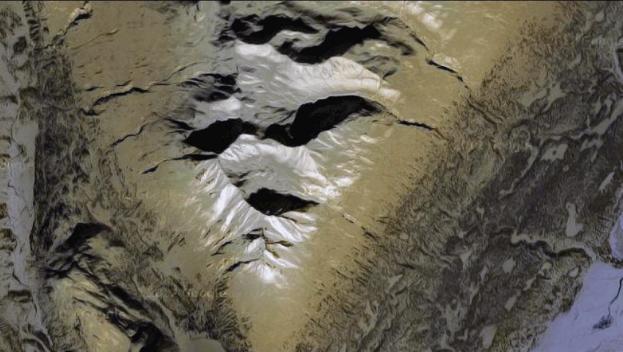 You’ve probably pointed out the face on the moon, or noticed that a puffy cloud looks exactly like Jeff Goldblum from a certain angle. If you like finding human faces in inanimate objects, you are in for a real treat: Artists from a Berlin-based generative design studio called Onformative created a project called “Google Faces,” and it unearths unnervingly human mugs on various surfaces around the world using facial recognition software and Google Maps.
You’ve probably pointed out the face on the moon, or noticed that a puffy cloud looks exactly like Jeff Goldblum from a certain angle. If you like finding human faces in inanimate objects, you are in for a real treat: Artists from a Berlin-based generative design studio called Onformative created a project called “Google Faces,” and it unearths unnervingly human mugs on various surfaces around the world using facial recognition software and Google Maps.
Onformative describes the Google Faces project as “an independent searching agent hovering the world to spot all the faces that are hidden on earth.” The Facetracker tool used to scan the globe for things that look like faces is still working, so the results aren’t complete yet, but what they’ve pulled up so far is pretty uncanny and may give you night terrors.
Even though the results are a little eerie, the methodology the Onformative team implemented to find these faces is impressive. They used Google Maps and applied a facial recognition algorithm using a facetracking library created by Jason Saragih. And the results speak for themselves.
Cedric Kiefer, one of Onformative’s founders explains the inspiration behind Google Faces. “The basic idea came while working on another project using face tracking technology,” he tells us. “At the beginning we had a high rate of false positives, the detection of a face when there is none.”
“We asked ourselves why that happened and what causes the computer to see a face in something else. A phenomenon that is called Pareidolia, the tendency to see faces in clouds or nature. For example the ‘Face on Mars’ taken by Viking 1 on July 25, 1976 is a good example for that phenomenon. We were curious to find out how the psychological phenomenon of Pareidolia could be generated by a machine and started to scan Google Maps to find such faces hidden in landscape.”
The project was not without its challenges, though. “Technically, the one challenge was the communication of our face recognition robot and Google Maps.”
Kiefer gave us a run-down of exactly how Google Faces works. “Our system mainly consists of two parts, an internet page containing nothing else then a full screen of Google Map hosted on one of our servers and a standalone application, the bot, browsing this internet page day in and day out. The bot continuously simulates clicks to move and zoom to the next desired image – making snapshots and running face recognition software.”
“In order to calculate the next position, it needs to keep track of the position it is looking at and the places it already traveled. Therefore the robot needs to calculate correct algorithmical steps and requests to navigate intelligent around the world and stay in tight communication exchange with the Google Maps API.”
But the biggest challenge for Onformative was the sheer number of scannable images. “Although the bot was running non stop for several weeks, we just travelled a small part of the world in different zoom levels so far,” he says. “So we don’t have any future plans what we could possibly do with the bot beside letting him run for some more month. Who knows what else he will find out there.”
We asked Kiefer if Google Faces could possibly search for more narrow facial features – for instance, only faces with mustaches, or images of Jesus (there’s a million dollar idea in the making). So far, the technology can’t winnow things down that far. “Searching for a special face, a face with a mustache or even an image of Jesus would require a different approach that is not possible with the current version of this software,” Kiefer explains.
So you can’t scour Google Maps for Elvis’ face on a chip just yet, but the technology is getting there. In the meantime, check out Onformative’s photo gallery of some of the most interesting faces they’ve found by scanning our planet.
[Image credit: Google]

